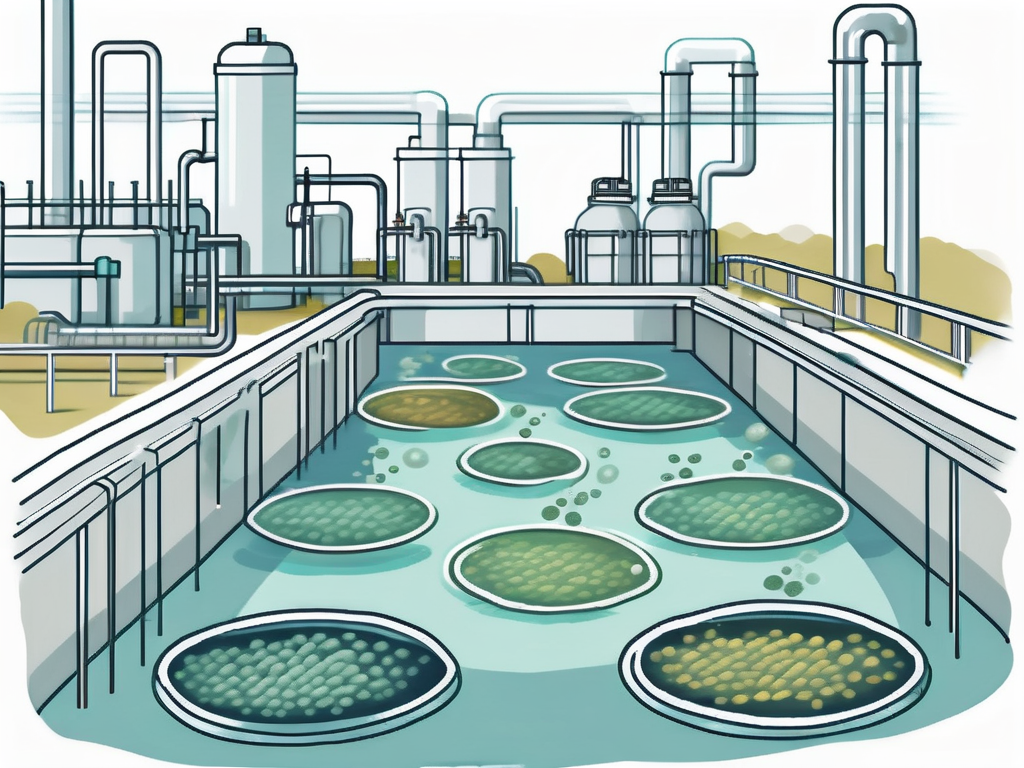
Nitrifying Bacteria: Wastewater Treatment Explained
The process of wastewater treatment is a complex one, involving a myriad of biological, chemical, and physical processes. One of the key biological processes involved in this treatment is the action of nitrifying bacteria. These microorganisms play a crucial role in the conversion of harmful nitrogenous compounds into less harmful forms, thus making the water safer for discharge or reuse.
Nitrifying bacteria are a group of chemolithotrophic organisms that include species like Nitrosomonas, Nitrobacter, Nitrospira, and Nitrococcus. These bacteria are responsible for the process of nitrification, which is a part of the nitrogen cycle. Nitrification is the biological oxidation of ammonia or ammonium to nitrite followed by the oxidation of these nitrites to nitrates.
Role of Nitrifying Bacteria in Wastewater Treatment
The role of nitrifying bacteria in wastewater treatment cannot be overstated. These bacteria are responsible for the conversion of harmful nitrogenous compounds into less harmful forms. This is particularly important in wastewater treatment, as high levels of nitrogenous compounds can be toxic to aquatic life and can also lead to eutrophication in water bodies.

During the wastewater treatment process, nitrifying bacteria convert the ammonia and ammonium present in the wastewater into nitrite and then into nitrate. This process, known as nitrification, is a crucial step in the removal of nitrogen from wastewater. Without the action of these bacteria, the nitrogen in the wastewater would remain in a harmful form and could cause significant environmental damage when the treated water is discharged.
Ammonia and Ammonium Conversion
The first step in the nitrification process is the conversion of ammonia (NH3) and ammonium (NH4+) into nitrite (NO2-). This step is carried out by bacteria of the genus Nitrosomonas. These bacteria oxidize ammonia or ammonium to produce nitrite, a process that also releases energy which the bacteria use for growth and reproduction.
It's important to note that the conversion of ammonia and ammonium into nitrite is an aerobic process, meaning it requires oxygen. This is why aeration is an important part of the wastewater treatment process. Without sufficient oxygen, the Nitrosomonas bacteria cannot carry out their function, and the nitrification process would be hindered.
Nitrite to Nitrate Conversion
Following the conversion of ammonia and ammonium into nitrite, the next step in the nitrification process is the conversion of nitrite into nitrate (NO3-). This step is carried out by bacteria of the genus Nitrobacter. Like the previous step, this process also requires oxygen and releases energy that the bacteria use for growth and reproduction.
The conversion of nitrite into nitrate is a crucial step in the nitrification process. Nitrate is much less harmful than nitrite and can be further processed by other bacteria in the wastewater treatment process to produce nitrogen gas, which can be safely released into the atmosphere.
Conditions for Nitrification
For nitrification to occur effectively, certain conditions need to be met. These include sufficient oxygen levels, appropriate temperature, and the correct pH. The presence of certain substances, such as heavy metals, can inhibit the nitrification process.
Oxygen is a crucial factor in the nitrification process. Both Nitrosomonas and Nitrobacter bacteria require oxygen to carry out their functions. Therefore, aeration is an important part of the wastewater treatment process. Without sufficient oxygen, the nitrification process would be hindered.
Temperature and pH
The temperature and pH of the wastewater can also affect the nitrification process. Nitrifying bacteria are most active at temperatures between 20 and 30 degrees Celsius. At lower temperatures, their activity decreases, which can slow down the nitrification process.
The pH of the wastewater is also important. Nitrifying bacteria prefer a pH between 7.0 and 8.0. Outside this range, their activity can be inhibited. Therefore, maintaining the correct pH is crucial for the efficient functioning of the nitrification process.
Inhibiting Factors
There are several factors that can inhibit the nitrification process. These include the presence of certain substances, such as heavy metals, certain organic compounds, and high concentrations of ammonia or nitrite.
Heavy metals, such as copper, zinc, and mercury, can be toxic to nitrifying bacteria and can inhibit their activity. Certain organic compounds can also inhibit nitrification. High concentrations of ammonia or nitrite can also inhibit the nitrification process. Therefore, it's important to monitor the composition of the wastewater to ensure that these inhibiting factors are kept in check.
Monitoring Nitrification
Monitoring the nitrification process is an important part of wastewater treatment. This can be done by measuring the concentrations of ammonia, nitrite, and nitrate in the wastewater. A decrease in ammonia and nitrite concentrations and an increase in nitrate concentration indicate that nitrification is occurring.
Other parameters that can be monitored include the oxygen concentration, pH, and temperature of the wastewater. These parameters can provide information about the conditions in the wastewater and can help identify any issues that might be hindering the nitrification process.
Ammonia, Nitrite, and Nitrate Concentrations
Monitoring the concentrations of ammonia, nitrite, and nitrate in the wastewater is a direct way to assess the progress of the nitrification process. A decrease in ammonia and nitrite concentrations and an increase in nitrate concentration indicate that nitrification is occurring.
However, it's important to note that these measurements only provide a snapshot of the nitrification process at a specific point in time. Therefore, regular monitoring is necessary to get a complete picture of the nitrification process.
Oxygen, pH, and Temperature
Monitoring the oxygen concentration, pH, and temperature of the wastewater can provide information about the conditions in the wastewater. These parameters can affect the activity of the nitrifying bacteria and, therefore, the progress of the nitrification process.
For example, a decrease in oxygen concentration could indicate that the aeration system is not working properly, which could hinder the nitrification process. Similarly, a pH outside the optimal range for nitrifying bacteria could inhibit their activity. Therefore, monitoring these parameters can help identify any issues that might be affecting the nitrification process.
Importance of Nitrifying Bacteria in Wastewater Treatment
Nitrifying bacteria play a crucial role in wastewater treatment. By converting harmful nitrogenous compounds into less harmful forms, they make the water safer for discharge or reuse. Without the action of these bacteria, the nitrogen in the wastewater would remain in a harmful form and could cause significant environmental damage when the treated water is discharged.

Furthermore, the nitrification process carried out by these bacteria is a natural process that does not require the addition of chemicals. This makes it a sustainable and environmentally friendly method of wastewater treatment. Therefore, understanding and optimizing the role of nitrifying bacteria in wastewater treatment is crucial for the efficient and sustainable treatment of wastewater.
Environmental Impact
The environmental impact of nitrifying bacteria in wastewater treatment is significant. By converting harmful nitrogenous compounds into less harmful forms, they prevent these compounds from being discharged into water bodies, where they could cause eutrophication and harm aquatic life.
Furthermore, the nitrification process carried out by these bacteria is a natural process that does not require the addition of chemicals. This makes it a sustainable and environmentally friendly method of wastewater treatment. Therefore, the role of nitrifying bacteria in wastewater treatment is crucial for environmental protection.
Sustainability
The nitrification process carried out by nitrifying bacteria is a natural process that does not require the addition of chemicals. This makes it a sustainable and environmentally friendly method of wastewater treatment. By optimizing the conditions for nitrification, wastewater treatment plants can reduce their reliance on chemical treatments and make their operations more sustainable.
Furthermore, the nitrification process can be integrated into other biological treatment processes, such as denitrification, to achieve complete nitrogen removal from wastewater. This integrated approach can further enhance the sustainability of wastewater treatment operations.
Conclusion
In conclusion, nitrifying bacteria play a crucial role in wastewater treatment. They are responsible for the conversion of harmful nitrogenous compounds into less harmful forms, making the water safer for discharge or reuse. Understanding and optimizing the role of these bacteria in wastewater treatment is crucial for the efficient and sustainable treatment of wastewater.
By monitoring the nitrification process and maintaining the optimal conditions for these bacteria, wastewater treatment plants can enhance their operations and reduce their environmental impact. Therefore, nitrifying bacteria and the nitrification process they carry out are integral parts of the wastewater treatment process.



